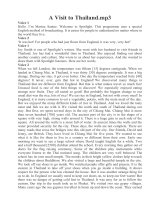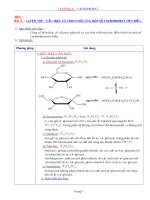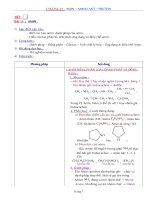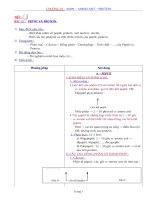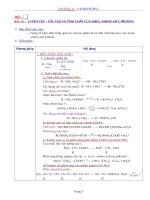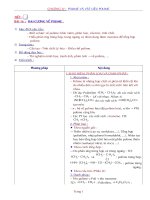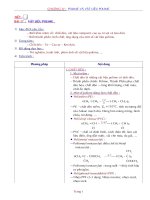Nội dung bài nghe: A visit../Alison../Aid ..(hay)
Bạn đang xem bản rút gọn của tài liệu. Xem và tải ngay bản đầy đủ của tài liệu tại đây (108.63 KB, 7 trang )
A Visit to Thailand.mp3
Voice 1
Hello. I’m Marina Santee. Welcome to Spotlight. This programme uses a special
English method of broadcasting. It is easier for people to understand no matter where in
the world they live.
Voice 2
‘It was hot! For people who had just flown from England, it was very, very hot!’
Voice 1
Joy Smith is one of Spotlight’s writers. She went with her husband to visit friends in
Thailand. Joy has had a wonderful time in Thailand. She enjoyed finding out about
another country and culture. She wrote to us about her experiences. And she wanted to
share them with Spotlight listeners. Here are her words.
Voice 2
When we left London, the temperature was fifteen [15] degrees centigrade. When we
landed in Chiang Mai, in Thailand, it was thirty [30] degrees centigrade. It was a big
change. During our stay, it got even hotter. One day the temperature reached forty [40]
degrees! It never, ever, gets that hot in England! We discovered many things in
Thailand that are different from England. But that is what makes travel so much fun!
Unusual food is one of the best things to discover! We especially enjoyed eating
strange new fruits. They all tasted so good! But probably the biggest change to our
usual diet was the rice, lots of rice! We eat rice in England, but not with every meal! In
England, it is more common to eat a vegetable, potato, with the main meal of the day.
But we enjoyed the many different kinds of rice in Thailand. And we loved the tasty
meat and fish we ate with it. We visited the north and south of Thailand during our
stay. But first, we spent several days in the city of Chiang Mai. Chiang Mai is more
than seven hundred [700] years old. The ancient part of the city is in the shape of a
square with very high, strong walls around it. There is a huge gate in each side of the
square. All around the walls is a moat full of water. In ancient times the walls and the
water provided security for the city. These days, the walls are not complete. There are
many roads that cross the bridges into this old part of the city. Our friends, David and
Jenny, are British. They have lived in Chiang Mai for five years. We wanted to see
what it is like for them to live in a country so different from their own. Early one
morning we went to see a large school where David taught English for a while. Two
and a half thousand [2500] children attend the school. Every morning they gather out of
doors for the flag raising ceremony. Some of the children play instruments while
everyone listens to the Thai national song. The children are very well behaved. The
school has its own small temple. The monks in their bright yellow clothes help to teach
the children about Buddhism. We also visited a large and beautiful temple in the city.
We took off our shoes to go inside. We watched people offer gifts and prayers. It is the
custom in Thailand to take off your shoes when you go inside a building. It shows
respect for the person who has cleaned the house. But it was another strange thing for
us to do. In England we usually need to keep our shoes on, to keep our feet warm! But
there was no danger of getting cold feet in Thailand. It was easy for us to follow the
custom. Our trip to the south took us to Phuket. We visited two sea gypsy villages.
Many years ago the sea gypsies travelled in boats up and down the coast. They earned
money by selling the fish they caught. These days, they are settled in villages on the
coast. But they still live by catching and selling fish. Many of their houses were
destroyed or damaged when the tsunami hit Phuket. Even worse, their boats were
destroyed. If they could not fish, they could not earn any money. Without money, they
could not repair their houses. Our friend David works for a Christian company in
Thailand. They sent people to Phuket to see what they could do for the sea gypsies. The
government was helping - but it was such a big job! David knew we would want to help
too. The members of our church in England collected a large amount of money. We
sent it to David. He used it to repair houses and boats. It was great to see all the new
houses for ourselves. We met some of the sea gypsies and worshipped God with them
in their church. We were even there to help push a new boat into the water for the first
time! After two days we flew back to Chiang Mai. There were still many things we
wanted to do before we returned to England. One thing we could not miss was the
chance to ride on an elephant. These huge animals are very useful. They can do heavy
work that no human could do. They are also very intelligent. They can learn to do many
things - even how to paint a picture! We watched an elephant paint a picture of a tree
with brown branches, green leaves and red flowers! It was very surprising! Riding an
elephant was another new experience for us. A young man sat on the huge head of each
animal and directed where it should go. We sat on a seat on the back of the elephant.
We crossed a deep, fast flowing river and travelled through the forest. It was great
fun! Each area of Thailand has something special to see. In the north there are
mountains, forests and many ancient buildings. We enjoyed driving through the
beautiful countryside to the Golden Triangle. This is where you can see the countries of
Burma, Laos and Thailand all at the same time. The Mekong River separates the
countries from each other. The north of Thailand is also where the hill tribes live. Their
way of life has not changed very much for hundreds of years. The men fish in the rivers
and grow rice. The women weave cloth and make beautiful things to sell. We travelled
in a fast, narrow boat to visit them. The river was full of large rocks. The boatman very
skilfully avoided the rocks. It was another new, fun experience for us. We left Thailand
with many pictures and happy memories. The gentle, smiling people had made us very
welcome. We are hoping that, one day, we will be able to go there again.
Voice 1
The writer of today’s programme was Joy Smith. The producer was Elizabeth Lickiss.
The voices you heard were from the United Kingdom. Computer users can hear our
programmes, read our scripts and see our word book at www.radio.english.net. This
programme is called ‘A Visit to Thailand’. Thank you for joining us in today’s
programme. Goodbye.
Alison Lapper.mp3
Voice 1
Hello. I’m Elizabeth Lickiss.
Voice 2
And I’m Marina Santee. Welcome to Spotlight. This programme uses a special English
method of broadcasting. It is easier for people to understand, no matter where in the
world they live.
Voice 3
‘Why shouldn’t my body be art?’
Voice 1
Alison Lapper asked this question. Alison’s body does not fit into the world’s idea of
what is ‘normal’. People have asked - ‘why should she consider her body to be art?’
Alison says. ‘Why not?’ Alison’s body looks different to other people’s. And this is
exactly why artist Marc Quinn wanted to make a statue of her.
Voice 2
Marc made a statue of Alison’s body with white marble stone. It now stands in a very
important place in London. It is in the fourth corner of Trafalgar Square. The other
three corners have permanent statues. But the fourth corner has its statue changed every
year or two. In September 2005, Marc Quinn’s statue was placed in the fourth corner.
The statue is called, ‘Alison Lapper Pregnant.’ So who is Alison Lapper? And what is
her story?
Voice 1
Alison was born in April 1965. When Alison was born, doctors quickly took her from
her mother. They hurried around. Her mother wondered what was happening. Where
was the baby? Then, a cleaner said, ‘Can you hear all that noise? A baby’s just been
born. She has no arms or legs. It is a horrible looking thing. The doctors say she will
probably die in a day or two.’
Voice 2
Alison’s mother did not know then that they were talking about her baby. She spoke to
her doctor. He told her that it would be best if the state looked after her baby. She
should get on with her life. Later, Alison said,
Voice 3
‘And so there I was. Alison Lapper - aged one week. I had no arms. My legs had no
knees, just the thighbone ending in my feet. They were not quite right either. My
condition was phocomelia. The Internet Medical Dictionary describes it as, “A birth
defect, where the hands and feet are attached to abbreviated (shortened) arms and legs.”
No one knew the cause of phocomelia. I was considered, "severely disabled." I really
hate that term.’
Voice 1
Alison spent her childhood in a children’s home. There were about two hundred and
fifty [250] children there. Some had mental difficulties. Others had physical problems.
Alison spent many unhappy years in the children’s home. Some of the workers treated
the children very badly - causing them mental and physical pain.
Voice 2
When Alison was eleven years old, her life improved. She moved to a different part of
the children’s home. Here, the children were in small groups. Each group had a woman
who acted as the children’s mother. They wanted to make it more of a family
atmosphere. But Alison said,
Voice 3
‘These days, the children’s home is a friendlier place. The children are well cared for.
However, for us it was too little too late.’
Voice 2
Alison left the home at the age of sixteen [16]. She moved to a training centre for
young people. Here, she learned the necessary skills to live alone. And, at the age of
nineteen [19] she moved to a home of her own in London. She said,
Voice 3
‘I became a carefree person. I enjoyed the discoveries of each new day. It was as if I
had been set free from prison’.
Voice 2
Alison continued with her art education. She was clearly skilled and gifted. At Art
College she enjoyed painting life-size pictures. One day, one of her art teachers looked
at her work. She commented,
Voice 4
‘I think you paint all these pictures of beautiful people because you do not want to deal
with how you look - who you really are.’
Voice 1
At first, Alison was shocked and hurt. But then she began to think about her teacher’s
words. She said,
Voice 3
‘It was true. I had never really looked deeply at who I was. Maybe she had made me
see something that was very important.’
Voice 2
Alison remembers looking through some art books one day. One of the books fell open
at a picture of the ancient Greek statue, Venus de Milo. The female statue is made from
white marble stone. The woman has both arms missing. Alison began to look at her
own body. She began to think about how she, and others, felt about her.
Voice 1
For the first time, Alison made images of herself. She sat in her art room and examined
the images. She said,
Voice 3
‘I thought, “Yes you are different. But you are not that different. You look pretty good
here girl.”’
Voice 2
Alison left university in 1993. She used the money from her art to buy a house. Life
was good. Two big events then changed her life again.
Voice 1
The first event was an art gallery asked to show her work.
Voice 2
The second big event was that Alison became pregnant. Her pictures included images
of her body, without clothes. She hoped the pictures would help able-bodied people to
accept the way she looked. She said,
Voice 3
‘I wanted people to maybe experience the idea that disability could be artistic - and
even beautiful.’
Voice 1
Artist Marc Quinn seemed to share Alison’s hopes. He contacted Alison in 1999. He
wanted to make a sculpture, a kind of statue, of her body. Alison laughed. She told him
that she was nearly seven months pregnant. ‘That is even better,’ he said. So Alison
agreed.
Voice 2
Marc Quinn’s sculpture of Alison is four point seven [4.7] metres high. It stands near to
the statue of Nelson on his column in Trafalgar Square. Nelson is a hero because he
won victory over the outside world. Some people say that Alison is also a hero. Her
statue represents winning victory over your own situations. Alison has proved many
critics wrong. She is a successful artist. And she is a successful mother. Her child is
healthy and happy. One writer says that the statue represents overcoming the judgments
of other people.
Voice 1
This strong message leads some people to say that the statue of Alison is not art. It is
just a statue with a message. Alison disagrees. She says,
Voice 3
‘Anything that we are not at ease with, we avoid. But now I am up there - almost five
metres high. You cannot avoid me any more. Why shouldn’t my body be art if Naomi
Campbell’s is? People want things to be boring and safe. That is why the statue is
causing debate.’
Voice 2
Whatever people say, Alison is pleased that they are saying something! The statue of
Alison may make people question their own ideas about normality, art and beauty. But
if it does, in Alison’s eyes, that is progress.
Voice 1
The writer and producer of today’s programme was Marina Santee. The voices you
heard were from the United Kingdom, the United States and Canada. Computer users
can hear our programmes on our website at www.radio.english.net. This programme is
called, ‘Alison Lapper.’ Thank you for joining us today. Good-bye
